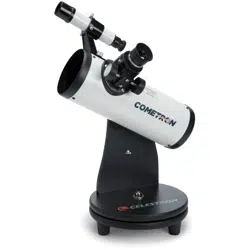Loading ...
Loading ...
Loading ...

7
F
F
o
o
c
c
u
u
s
s
i
i
n
n
g
g
To focus your FirstScope telescope, simply turn the focus knob located
directly below the eyepiece. Turning the knob clockwise allows you to
focus on an object that is farther than the one you are currently observing.
Turning the knob counterclockwise from you allows you to focus on an
object closer than the one you are currently observing.
Note: If you wear corrective lenses (specifically glasses), you may want to
remove them when observing with an eyepiece attached to the telescope. If
you have astigmatism, corrective lenses must be worn at all times.
Figure 3-3
C
C
a
a
l
l
c
c
u
u
l
l
a
a
t
t
i
i
n
n
g
g
M
M
a
a
g
g
n
n
i
i
f
f
i
i
c
c
a
a
t
t
i
i
o
o
n
n
You can change the power of your telescope just by changing the eyepiece (ocular). To determine the
magnification of your telescope, simply divide the focal length of the telescope by the focal length of the eyepiece
used. In equation format, the formula looks like this:
Focal Length of Telescope (mm)
Magnification =
Focal Length of Eyepiece (mm)
Let’s say, for example, you are using the 20mm eyepiece that came with your telescope. To determine the
magnification you simply divide the focal length of your telescope (the FirstScope for this example has a focal length
of 300mm) by the focal length of the eyepiece, 20mm. Dividing 300 by 20 yields a magnification of 15 power.
The FirstScope has a usable magnification range of 10x (lowest power) to 150x (highest power) with various
optional accessories. The standard accessories supplied with the FirstScope provide you with 15x and 75x.
D
D
e
e
t
t
e
e
r
r
m
m
i
i
n
n
i
i
n
n
g
g
F
F
i
i
e
e
l
l
d
d
o
o
f
f
V
V
i
i
e
e
w
w
Determining the field of view is important if you want to get an idea of the angular size of the object you are
observing. To calculate the actual field of view, divide the apparent field of the eyepiece (supplied by the eyepiece
manufacturer) by the magnification. In equation format, the formula looks like this:
Apparent Field of Eyepiece
True Field =
Magnification
As you can see, before determining the field of view, you must calculate the magnification. Using the example in
the previous section, we can determine the field of view using the same 20mm eyepiece that is supplied standard
with the FirstScope telescope. The 20mm eyepiece has an apparent field of view of 25°. Divide the 25° by the
magnification, which is 15 power. This yields an actual field of 1.7°.
To convert degrees to feet at 1,000 yards (which is more useful for terrestrial observing) multiply the angular field
of view by 52.5. Multiply the angular field of 1.7° by 52.5. This produces a linear field width of 89 feet at a
distance of one thousand yards or 29 meters @ 1,000 meters.
G
G
e
e
n
n
e
e
r
r
a
a
l
l
O
O
b
b
s
s
e
e
r
r
v
v
i
i
n
n
g
g
H
H
i
i
n
n
t
t
s
s
When working with any optical instrument, there are a few things to remember to ensure you get the best possible
image. If you wear corrective lenses (specifically glasses) you may want to remove them when looking through the
telescope unless you have astigmatism.
y Never look through window glass. Glass found in household windows is optically imperfect, and as a result,
may vary in thickness from one part of a window to the next. This inconsistency can and will affect the ability
to focus your telescope. In most cases you will not be able to achieve a truly sharp image and may actually see
a double image.
y Never look across or over objects that are producing heat waves. This includes asphalt parking lots on hot
summer days or building rooftops.
y Hazy skies, fog, and mist can also make it difficult to focus when viewing terrestrially. The amount of detail
seen under these conditions is greatly reduced.
Loading ...
Loading ...
Loading ...
